Laxmikanth Summary: State Legislature | Indian Polity for UPSC CSE PDF Download
State Legislature
Man is the only animal that laughs and has a state legislature. -Samuel Butler
Indian state legislatures represent decentralized governance in India's federal system. Elected representatives within these bodies have the authority to create laws and policies regionally, ensuring democratic representation and decision-making across the country's diverse regions.
Articles 168 to 212 in Part VI of the Constitution deal with the organisation, composition, duration, officers, procedures, privileges, powers and so on of the state legislature. Though these are similar to that of Parliament, there are some differences as well.
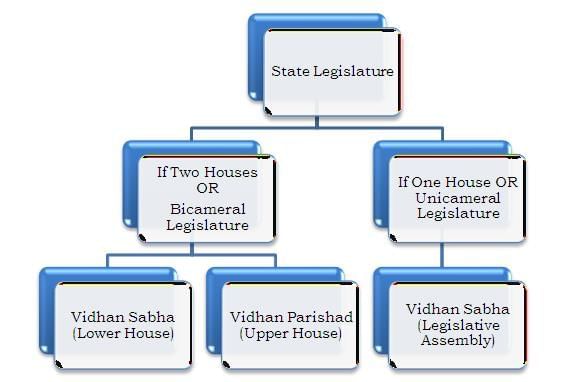 State Legislature
State Legislature
Organization of State Legislature
- Most state legislatures in India differ in their structure, with some following are unicameral system and others are bicameral system.
- Presently, only six states - Andhra Pradesh, Telangana, Uttar Pradesh, Bihar, Maharashtra, and Karnataka - have two Houses (bicameral).
- States with a unicameral system comprise the governor and the legislative assembly, while those with a bicameral system include the governor, the legislative council, and the legislative assembly.
- The legislative council acts as the upper house, while the legislative assembly serves as the lower house.
- According to the Constitution (Article 169), the creation or abolition of legislative councils in states can be facilitated by Parliament through a special resolution passed by the concerned state's assembly.
- Having a second chamber in states faced criticism during the Constituent Assembly due to concerns about representation, delay in the legislative process, and the cost involved.
- The legislative council of Tamil Nadu had been abolished in 1986 and that of Punjab and West Bengal in 1969.
- For instance, Tamil Nadu passed a resolution in 2010 to establish a Legislative Council but later passed another resolution in 2011 seeking its abolition before the corresponding Act was enacted.
Composition of Two Houses
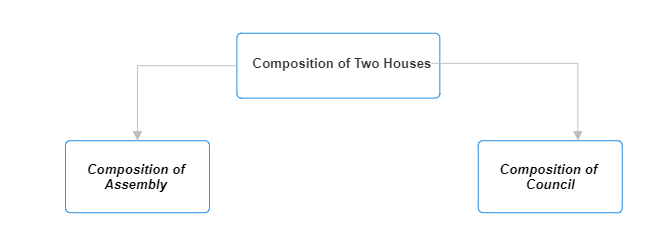
Composition of the Assembly
- Strength: The assembly consists of individuals directly elected by the state's people. The number of members varies by state, determined by population size. Larger states have more members compared to smaller ones. Its maximum strength is fixed at 500 and minimum strength at 60. It means that its strength varies from 60 to 500 depending on the population size of the state.
- Nominated Member:- Before 2020, the Governor could nominate one member of the Anglo-Indian community to the State Legislative Assembly if the community was not adequately represented. This provision, originally meant to last only till 1960, was extended repeatedly, with the last extension made by the 95th Amendment Act, 2009, up to 2020. However, the 104th Amendment Act, 2019 discontinued this provision, and it ceased to be effective from 25th January 2020.
- Territorial Representation: Members represent specific geographic constituencies within the state. Each constituency elects one representative, demarcated based on population and administrative convenience.
- Readjustment after each Census: After each census, Parliament readjusts State Assembly seats and constituencies through Delimitation Acts (1952, 1962, 1972, 2002). The 42nd Amendment (1976) froze this till 2000, and the 84th Amendment (2001) extended it to 2026 to promote population control. Constituency boundaries were later allowed to be adjusted using the 2001 census (87th Amendment, 2003) without changing the total number of seats.
- Reservation of seats for SCs and STs: Some assembly seats are reserved for marginalized groups like Scheduled Castes (SCs) and Scheduled Tribes (STs) to ensure fair representation. The number of reserved seats corresponds to the SCs' and STs' population in the state.
- Duration: The assembly's term spans five years unless dissolved earlier by the Governor or upon completing its term.
- Speaker and Deputy Speaker: The assembly elects a Speaker and Deputy Speaker from its members. The Speaker oversees proceedings while ensuring orderliness, while the Deputy Speaker assists and assumes responsibility in the Speaker's absence.
- Powers and Functions: The legislative assembly wields significant authority, including lawmaking, budget approval, and overseeing the government through debates and resolutions.
Composition of Council
- Strength: The members of the Legislative Council are indirectly elected, unlike the directly elected members of the Legislative Assembly. The maximum strength of the council is fixed at one-third of the total strength of the assembly and the minimum strength is fixed at 40. This means the size of the council varies according to the size of the assembly in that state. This provision ensures the dominance of the directly elected assembly in the state's legislative matters.
- Membership Diversity:The Council comprises elected and nominated members from diverse groups:
- Elected Members: These individuals are elected by various bodies like local authorities, graduates, teachers, and registered graduates.
- Nominated Members: Appointed by the Governor, these members come from fields such as literature, science, arts, social service, economics, or industry, adding expertise to the Council.
- Representation: Members represent different territorial constituencies within the state, varying in size based on population distribution and administrative convenience.
- Special Representation:The Council ensures representation for specific groups:
- Local Authorities: Members elected by local government bodies like municipalities and district boards.
- Graduates and Teachers: Reserved seats for graduates and teachers provide them representation in the Council.
- Nominated Experts: Individuals with expertise in various fields are nominated, contributing diverse perspectives to the Council's discussions.
- Manner of Election: Of the total number of members of a legislative council:
- 1/3 are elected by the members of local bodies in the state like municipalities, district boards, etc.,
- 1/12 are elected by graduates of three years standing and residing within the state,
- 1/12 are elected by teachers oi three years standing in the state, not lower in standard than secondary school,
- 1/3 are elected by the members of the legislative assembly of the state from amongst persons who are not members of the assembly, and
- The remainder are nominated by the governor from amongst persons who have a special knowledge or practical experience of literature, science, art, cooperative movement and social service.
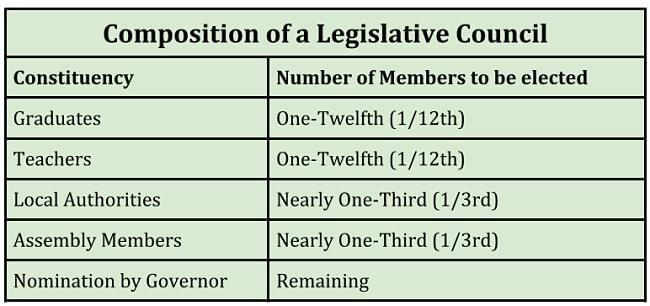
- Term: Members typically serve a six-year term, with one-third retiring every two years, ensuring continuity while allowing new entrants.
- Leadership: Similar to the Assembly, the Council elects a Chairperson and a Deputy Chairperson from its members. The Chairperson oversees sessions, maintaining order, while the Deputy assists and takes charge in their absence.
- Functions: The Legislative Council possesses substantial powers, participating in legislation, reviewing bills, proposing amendments, and serving as a revising chamber. It facilitates thorough discussions and offers alternative perspectives on proposed laws.
Duration of Two Houses
Duration of Legislative Assembly (Vidhan Sabha)
- Duration: Members of the Legislative Assembly serve a five-year term, starting from their first sitting, unless dissolved earlier.
- Premature Dissolution: If dissolved prematurely due to reasons like the Governor's decision or completing the five-year term, elections are held promptly to form a new assembly.
- Extension: Under Article 356 (President's Rule), the Assembly's term can extend by up to one year upon Parliament's approval if the state faces such circumstances.
Duration of Legislative Council (Vidhan Parishad)
- Duration: Like the Rajya Sabha, the legislative council is a continuing chamber, that is, it is a permanent body and is not subject to dissolution. But, one-third of its members retire on the expiration of every second year. So, a member continues as such for six years.
- Rotational System: This system ensures that one-third of the Council's members, nominated and elected, retire after completing a six-year term.
- Renewal: Simultaneously, fresh elections and nominations occur to fill these vacated positions in the Council, allowing for a continuous presence and periodic infusion of new members.
This distinction in duration signifies the unique characteristics of these legislative bodies. While the Assembly operates on a fixed five-year term, the Council employs a rotational system, maintaining continuity and periodically introducing new representation.
Membership of State Legislature
1. Qualifications for Membership
- Assembly (MLA): To be an MLA, a candidate must be an Indian citizen, at least 25 years old, and listed on the state's electoral roll.
- Council (MLC): For MLCs, the criteria include citizenship, a minimum age of 30 years, and being on the state's electoral roll or representing a graduate constituency within the state.
2. Disqualifications
- Grounds of Disqualification: A member can face disqualification for holding an office of profit, unsoundness of mind, being an undischarged insolvent, or voluntarily acquiring citizenship or allegiance to a foreign state.
- Dual Membership: Simultaneous membership in both the assembly and council is not permitted.
3. Oath or Affirmation:
Before assuming their seats in the assembly or council, members must take an oath or affirmation specified in the Third Schedule of the Indian Constitution. The oath is administered by the Governor or a designated official.
Provisions related to oath, penalties, and salaries of state legislature members are as follows:
A member cannot vote, participate in House proceedings, or enjoy legislative privileges until they take the prescribed oath.
A penalty of ₹500 per day is imposed if a person sits or votes as a member:
(a) before taking the oath,
(b) while knowing they are unqualified or disqualified, or
(c) when prohibited by law from sitting or voting.Members receive salaries and allowances as decided by the state legislature from time to time.
4. Vacation of Seats:
- Disqualification: Seats can become vacant if a member incurs disqualification according to the specified grounds.
- Resignation: Members can resign by submitting their resignation to the Speaker (for the assembly) or the Chairman (for the council).
- Absence: Prolonged absence from the house without permission may also lead to the vacation of seats.
Presiding Officers of State Legislature
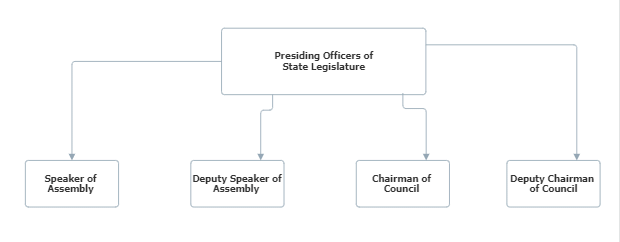 Presiding officers of State Legislature
Presiding officers of State Legislature
Each House of state legislature has its own presiding officer. There is a Speaker and a Deputy Speaker for the legislative assembly and Chairman and a Deputy Chairman for the legislative council. A panel of chairmen for the assembly and a panel of vice-chairmen for the council is also appointed.
Speaker of Assembly
- Elected by Assembly members to uphold the Assembly's dignity and impartiality.
- Responsibilities include presiding over sessions, maintaining order, and deciding on procedural matters.
- Grants or denies permission for members to speak and ensures fair debates.
- Typically refrains from participating in debates or voting, except in the case of tie-breaking.
Deputy Speaker of the Assembly
- Assists the Speaker and takes charge in the Speaker's absence.
- Ensures the smooth functioning of the Assembly.
Chairman of the Council
- Presides over the Legislative Council, maintaining order and guiding procedural matters.
- Similar role to the Speaker but within the Legislative Council.
Deputy Chairman of the Council
- Supports the Chairman and assumes leadership in the Chairman's absence.
- Acts as the second-in-command within the Legislative Council.
Sessions of State Legislature
- Summoning: The governor from time to time summons each House of state legislature to meet. The maximum gap between the two sessions of state legislature cannot be more than six months, ie, the state legislature should meet at least twice a year.
- Adjournment: An adjournment suspends the work in a sitting for a specified time which may be hours, days or weeks. Adjournment sine die means terminating a sitting of the state legislature for an indefinte period. The power of the adjournment as well as adjournment sine die lies with the presiding officer of the House.
- Prorogation: The presiding officer (Speaker or Chairman) declares the House adjourned sine die, when the business of the session is completed. Within the next few days, the governor issues a notification for prorogation of the session.
- Dissolution: The legislative council, being a permanent house, is not subject to dissolution. Only the legislative assembly is subject to dissolution. Unlike a prorogation, a dissolution ends the very life of the existing House, and a new House is constituted after the general elections are held. The position with respect to lapsing of bills on the dissolution of the assembly is mentioned below:
1. A Bill pending in the assembly lapses (whether originating in the assembly or transmitted to it by the council).
2. A Bill passed by the assembly but pending in the council lapses.
3. A Bill pending in the council but not passed by the assembly does not lapse.
4. A Bill passed by the assembly (in a unicameral state) or passed by both the houses (in a bicameral state) but pending assent of the governor or the President does not lapse.
5. A Bill passed by the assembly (in a unicameral state) or passed by both the Houses (in a bicameral state) but returned by the president for reconsideration of House (s) does not lapse. - Quorum: Quorum is the minimum number of members required to be present in the Voting in House all matters at any sitting of either House are decided by a majority of votes of the members present and voting excluding the presiding officer.
- Voting in the House: Voting methods include voice votes, division (by standing or using electronic systems), or ballot, decided by the Speaker or Chairman. Determined based on the nature of the issue being voted upon.
- Language in State Legislature: State legislatures use official languages specified for proceedings, with translation services available if needed. Each state determines its official language(s) for legislative business.
- Rights of Ministers and Advocate General: State government ministers participate in House proceedings, introducing bills and representing the government. The Advocate General, a legal advisor, attends and engages in legal matter discussions within the House.
Legislative Procedure in State Legislature
In state legislatures, bills originate, undergo readings in both houses, receive assent from the Governor, and, for certain bills, may require consideration or assent from the President.
Ordinary Bill
- Bill in the Originating House: An ordinary bill can originate in either House of the state legislature (in case of a bicameral legislature). Such a bill can be introduced either by a minister or by any other member. The bill passes through three stages in the originating House, viz,
1. First reading (Introduction),
2. Second reading (Detailed Consideration), and
3. Third reading (Voting)
After the bill is passed by the originating House, it is transmitted to the second House for consideration and passage. - Bill in the Second House: The bill undergoes similar readings in the second house and may return to the originating house if amendments are suggested.
- Assent of the Governor:
- Once both houses agree on the final bill form, it's sent to the Governor.
- The Governor can give assent, withhold assent, or reserve the bill for the President's consideration in certain cases.
- Assent of the President: Bills reserved by the Governor may be sent to the President, who can give assent, withhold it, or request reconsideration.
Money Bills
- Introduction and Passage:
- Money bills focus on financial matters and are introduced only in the legislative assembly.
- After passing in the assembly, they are sent to the council for its recommendations.
- The council has a specific time frame for passing or it's considered approved.
- Assent of the Governor:
- Money bills, once passed by both houses, go to the Governor for assent, without the power to withhold it.
Bills Reserved For President's Consideration
Bills Mandated for President's Consideration
- Bills derogating High Court powers risking its constitutional role (Article 200).
- Bills on water/electricity taxes falling under Article 288.
- Bills during a financial emergency as per Article 360.
Bills Potentially Reserved for President's Consideration for Specific Purposes
- Bills aiming to secure immunity from Articles 14 and 19.
Bills related to acquisition of estates (Article 31A). - Bills implementing specific Directive Principles of State Policy (Article 31C).
- Bills related to Concurrent List subjects, ensuring their operation despite repugnancy to Union laws (Article 254).
- Bills imposing trade restrictions without prior Presidential sanction under Article 304.
Bills Open for Governor's Discretion
Bills not fitting specific categories yet open for Governor's reservation under Article 200 for President's consideration.
Legislative Procedure Compared
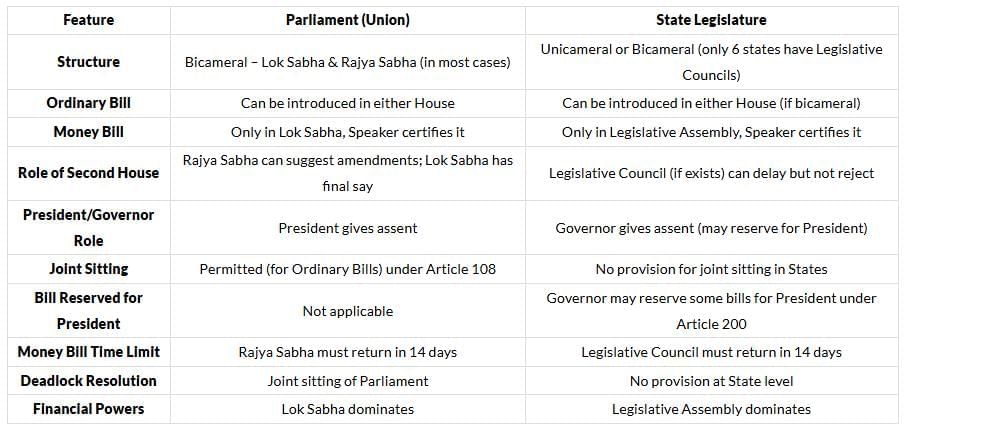
Position of Legislative Council
The constitutional position of the council (as compared with the assembly) can be studied from two angles:(a) Spheres where council is equal to assembly.
(b) Spheres where council is unequal to assembly.
Equal with Assembly
- Bicameral Equality Certain states adopt a balanced bicameral system where the Legislative Assembly and Council share equal legislative authority.
- Legislative Powers Both houses possess matching abilities in drafting, discussing, amending, and passing laws, necessitating approval from both for bills to become law.
- Checks and Balances This system ensures checks and balances in legislation, allowing comprehensive scrutiny and diverse perspectives on proposed laws.
- Representation Members elected or nominated to both houses represent constituents' interests, ensuring broader representation and diverse viewpoints.
Unequal with Assembly
- Limited Legislative Authority In some states, the Legislative Council holds a subordinate position compared to the Assembly, constraining its legislative functions.
- Secondary Role While the Council might propose amendments, the Assembly often holds the final decision, possibly bypassing the Council in bill approvals.
- Functional Restrictions The Council might face limitations, particularly concerning money bills and specific legislative domains.
- Uneven Representation In such scenarios, the Council might not equally represent constituents' concerns as the Assembly does.
Privileges of State legislature
Collective Privileges
- Freedom of Speech Members have the liberty to express themselves freely in legislative chambers during debates and discussions without facing legal repercussions.
- Right to Publish Proceedings Legislatures hold the authority to publish their sessions and reports, ensuring autonomy in sharing information about their proceedings.
- Control over Internal Affairs State legislatures have the right to regulate internal affairs, including maintaining order and discipline within the house.
- Exclusive Jurisdiction The legislature retains exclusive authority over its proceedings, preventing external interference in its decision-making process.
Individual Privileges
- Immunity Members enjoy immunity from legal actions for their speeches or votes within the legislative chamber, safeguarding them from legal consequences related to their statements during sessions.
- Right to Participate Each member possesses the right to actively engage in legislative proceedings, debates, and committees.
- Freedom from Arrest Members are protected from arrest during legislative sessions and certain periods before and after, enabling them to perform their duties without hindrance.
- Exemption from Jury Duty Legislators are exempted from jury service, allowing them to focus solely on their legislative responsibilities.
- Right to Publish Proceedings Individual members also hold the right to publish session proceedings, speeches, and reports made within the house.
|
142 videos|777 docs|202 tests
|
FAQs on Laxmikanth Summary: State Legislature - Indian Polity for UPSC CSE
| 1. What is the composition of the two houses in a state legislature? |  |
| 2. What is the duration of the sessions of the two houses in a state legislature? |  |
| 3. Who are the presiding officers of the state legislature, and what are their roles? |  |
| 4. What are the legislative procedures followed in a state legislature? |  |
| 5. What is the position of the Legislative Council in a state legislature? |  |






















